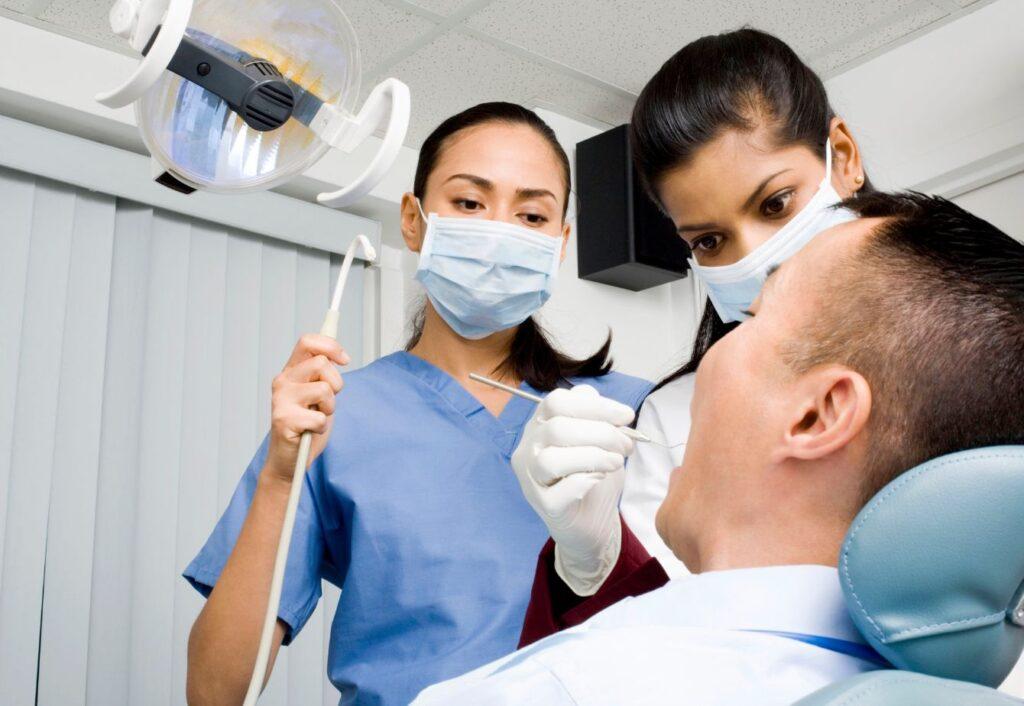Dental hygienists in the USA are oral healthcare professionals who provide preventive and therapeutic services to patients. They work under the supervision of dentists and perform tasks such as cleaning teeth, taking X-rays, applying fluoride, educating patients, and more.
Becoming a dental hygienist in the USA can be a rewarding and challenging career choice. It requires a combination of education, skills, license, and experience. A dental hygienist’s career also offers many benefits, such as job satisfaction, demand, income, and flexibility. It also involves some challenges, such as physical and mental stress, exposure to infections, legal liability, and more.
If you are interested in becoming a dental hygienist in the USA, this article will provide you with useful information on the education, roles, salary, and path of this profession. This article will help you understand what dental hygienists do, how they do it, how much they earn, and how to become one.
Education Requirements For Becoming a Dental Hygienist in the USA
The first step to becoming a dental hygienist in the USA is to complete a dental hygiene program from an accredited institution. There are different types and levels of dental hygiene programs available, such as:
- Associate’s degree. This is the minimum requirement for becoming a dental hygienist in the USA. It takes about two to three years to complete and covers general education, basic sciences, dental sciences, and clinical skills. Most dental hygiene programs in the USA are at the associate’s degree level.
- Bachelor’s degree. This is an optional choice for becoming a dental hygienist in the USA. It takes about four years to complete and covers more advanced topics and research in dental hygiene. Some dental hygiene programs in the USA are at the bachelor’s degree level.
- Master’s degree. This is another optional choice for becoming a dental hygienist in the USA. It takes about one to two years to complete and covers more specialized areas and leadership in dental hygiene. Some dental hygiene programs in the USA are at the master’s degree level.
Curriculum and Coursework:
The curriculum and coursework of dental hygiene programs vary depending on the type and level of the program. Some common subjects and topics that are covered in most dental hygiene programs are:
- Anatomy and physiology
- Microbiology and pathology
- Pharmacology and nutrition
- Dental materials and instruments
- Dental radiology and imaging
- Periodontology and oral pathology
- Dental hygiene theory and practice
- Oral health education and promotion
- Ethics and law
The accreditation of dental hygiene programs is done by the Commission on Dental Accreditation (CODA), which is a part of the American Dental Association (ADA). CODA sets the standards and criteria for dental hygiene programs and ensures that they meet the quality and competency requirements for preparing dental hygienists.
Admission criteria and Process:
Admission to dental hygiene programs is competitive and selective. The admission criteria and process vary depending on the institution and program.
- A high school diploma or equivalent with courses in math, science, and English
- A minimum grade point average (GPA) of 2.5 or higher
- A minimum score on standardized tests such as SAT or ACT
- A completed application form with a personal statement and fee
- Official transcripts from previous schools or colleges
- An interview with the admission committee
Some examples of reputable and accredited dental hygiene programs in the USA are:
- University of Michigan School of Dentistry: This is one of the top-ranked dental schools in the USA that offers both bachelor’s and master’s degree programs in dental hygiene.
- University of North Carolina at Chapel Hill Adams School of Dentistry: This is another top-ranked dental school in the USA that offers both bachelor’s and master’s degree programs in dental hygiene.
- University of Pennsylvania School of Dental Medicine: This is a prestigious dental school in the USA that offers a bachelor’s degree program in dental hygiene.
- University of Southern California Herman Ostrow School of Dentistry: This is a renowned dental school in the USA that offers both associate’s and bachelor’s degree programs in dental hygiene.
- University of Washington School of Dentistry: This is a leading dental school in the USA that offers both bachelor’s and master’s degree programs in dental hygiene.
Roles of a Dental Hygienist
The second step to becoming a dental hygienist in the USA is to understand the roles and responsibilities of this profession. Dental hygienists perform various tasks related to oral health care services for patients.
- Providing preventive services such as oral examinations, dental cleanings, fluoride treatments, sealants, etc.
- Providing therapeutic services such as scaling, root planing, polishing, etc.
- Taking x-rays or other images of teeth and jaws
- Applying local anesthesia or other medications as prescribed by dentists
- Educating and counseling patients on oral hygiene, nutrition, and disease prevention
- Collaborating and communicating with dentists and other dental team members on diagnosis and treatment planning
- Following infection control and safety protocols and regulations in dental settings
- Performing administrative and managerial tasks such as scheduling appointments, maintaining records, ordering supplies, etc.
Settings and Specialties:
Dental hygienists can work in different settings and specialties depending on their preferences and qualifications. Some of these settings and specialties are:
- Private or public dental offices or clinics: These are the most common settings where dental hygienists work. They provide general or specialized dental care services to patients of different ages and backgrounds.
- Schools or community health centers: These are settings where dental hygienists work with children or underserved populations. They provide preventive or educational dental care services to promote oral health and prevent dental diseases.
- Hospitals or nursing homes: These are settings where dental hygienists work with patients who have medical conditions or disabilities that affect their oral health. They provide supportive or palliative dental care services to improve their quality of life.
- Military or government agencies: These are settings where dental hygienists work with soldiers or public servants who need dental care services. They provide comprehensive or emergency dental care services to maintain their oral health and readiness.
- Research or education institutions: These are settings where dental hygienists work with researchers or educators who conduct studies or teach courses on dental hygiene. They provide data collection or analysis, curriculum development, or instruction services to advance the field of dental hygiene.
Salary of a Dental Hygienist
The third step to becoming a dental hygienist in the USA is to know the salary range and factors that affect the salary of this profession. Dental hygienists earn a decent income that reflects their skills and services. The average annual salary of dental hygienists in the U.S. was $77,230 in 2020.
The salary of dental hygienists can vary depending on factors such as experience, location, setting, education, certification, etc. Some of these factors are:
- Experience: The more experience a dental hygienist has, the more likely they are to earn a higher salary. Experienced dental hygienists can handle more complex cases, attract more clients, and negotiate better fees.
- Location: The location of Dental Hygienists in the USA can also affect their salary. Different states or regions may have different laws, regulations, costs of living, demand, and supply of dental hygienists. The highest-paying states for Dental Hygienists in the USA in 2020 were Alaska ($114,790), California ($106,240), Washington ($92,610), Arizona ($91,290), and New Jersey ($90.680).
- Setting: The setting of a dental hygienist can also impact their salary. Different settings may have different types, levels, and volumes of dental care services that require different skills, resources, and fees from dental hygienists. The highest-paying settings for Dental Hygienists in the USA in 2020 were offices of dentists ($77.910), offices of physicians ($74.820), outpatient care centers ($74.640), government ($70.300), and educational services ($69.370).
- Education: The education of a dental hygienist can also affect their salary. Higher levels of education may provide more knowledge, skills, opportunities, and recognition for dental hygienists. Higher levels of education may also require more time, money, and effort from dental hygienists.
- Certification: The certifications of Dental Hygienists in the USA can also affect their salary. Certifications may demonstrate more competence, professionalism, and credibility for dental hygienists. Certifications may also require more training, testing, and fees from dental hygienists.
How to Become Dental Hygienists in the USA
A dental hygienist is a professional who provides oral health care services to patients. They work in various settings and specialize in different areas of dentistry.
Steps and Timeline:
To become a dental hygienist, the steps are:
- Finish high school with math, science, and English courses (4 years).
- Get an associate’s degree in dental hygiene from an accredited program (2-3 years). Some programs may offer higher degrees as well.
- Pass the NBDHE (1 day), a written exam that tests your dental hygiene knowledge and skills.
- Pass a clinical board exam (1-2 days), a practical exam that tests your ability to perform dental hygiene procedures on patients.
- Apply for a state license (a few weeks), by submitting your documents and fees to the state board of dentistry and meeting any other requirements.
- Complete continuing education courses (varies by state), to maintain your license and keep up with the changes in the field.
Tips and Advice:
To prepare and succeed in this career path, you should:
- Choose a reputable dental hygiene program that matches your goals and interests. You can search for accredited programs on the website of the Commission on Dental Accreditation. You can also compare different programs based on their features.
- Study hard and gain experience in dental hygiene courses and clinics. You can use various resources and methods to study. You can also work with patients under supervision in clinics or externships.
- Join professional associations and networks such as the ADHA or the NDHA. These are organizations that support and advocate for dental hygienists. You can access their benefits such as education, career, networking, scholarships, awards, and more.
- Seek mentorship and guidance from experienced dental hygienists or dentists. You can learn from their insights, advice, feedback, and support. You can find mentors through your program, your employer, your associations, or online platforms.
- Explore different settings and specialties to find your niche and passion in dental hygiene. You can work in different settings such as private practices, corporations, government agencies, or non-profit organizations. You can also specialize in different areas such as pediatric dentistry, geriatric dentistry, public health dentistry, or forensic dentistry.
Becoming a dental hygienist in the USA offers a fulfilling career path for those passionate about oral health and patient care. Armed with an understanding of the education requirements, roles and responsibilities, salary prospects, and the path to becoming a dental hygienist, you can embark on a journey to promote better oral health and brighter smiles for your future patients. As a dental hygienist, you’ll not only contribute to healthier mouths but also to the overall well-being of your community.
Also, Read: What is an Academic Goal?






